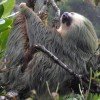Contents
Description

The Tortuguero National Park, founded in 1975, is located on the Caribbean coast of the Costa Rican province of Limón. It protects the valuable flora and fauna of the Caribbean lowlands and is a very popular tourist destination. The ideal starting point for exploring the unique canal and lagoon landscape as well as the dense jungle is the small village of Tortuguero.
The National Park Tortuguero: a unique flora and fauna
About 190 square kilometers of land and about 520 square kilometers of water are protected by the National Park Tortuguero. The fascinating, widely ramified canal and lagoon landscape is home to various river turtles, crocodiles, caimans, otters, manatees and alligator pike, among others. The rainforest offers shelter to jaguars, monkeys, sloths, iguanas and many other mammals. Also poisonous frogs, snakes, insects and about 375 bird species have their habitat here. In Tortuguero there is very little primary forest left today, most of the vegetation now consists of secondary forest. Nevertheless, it is home to about 400 species of trees and over 2200 species of plants. You can get more information and maps of the national park at the park stations.
Tortuguero - a small village in the middle of the national park
The village of Tortuguero in the middle of the national park has existed since about 1930, when a Colombian family settled there. It is situated on a narrow strip of land between the Caribbean beach and the wide jungle river. Around 1940, they started to cut down rainforest and developed the river arms into canals. This made it easier to transport the wood away. Since 1975 the national park is under protection and the main source of income for the 500 inhabitants of Tortuguero is today, besides fishing, the steadily growing tourism.
The "place where the turtles come" (Tortuguero)
The approximately 35-kilometre-long coastal strip, which is part of the national park, is an important breeding ground for the green sea turtles, which are threatened with extinction. Especially between June and September, the reptiles swim ashore in their thousands and bury their eggs in the sand under cover of darkness. Every two to three years the animals, which are about one metre long and weigh up to 200 kilos, lay around 100 eggs. 45 to 75 days later, during the night, the baby turtles hatch from their eggs and make their way to the sea. Besides the green sea turtles, leatherback turtles (April - June) as well as hawksbill and loggerhead turtles come here to lay their eggs. During a visit to Tortuguero National Park you can observe the fascinating experience of the nightly egg laying. However, only from a distance and without taking any photos so as not to disturb the animals. You can also watch the newly hatched turtles with your eyes - best in the early morning hours - on their way to the sea. As difficult as it is, you must not help them, because they have to master the natural way themselves. At the park's scientific research station, the behaviour and way of life of the turtles are studied in order to protect them even better.
On the way in Tortuguero National Park
There are various hiking trails around the park stations. At Jalova Station, for example, the 30-kilometre-long jungle trail to Tortuguero, which can only be reached by boat, begins. From the Agua Fria Station at the western border of the park, the hiking trail Los Raudales leads to a wonderful viewpoint. The Tortuguero Nature Trail, about two kilometres long, is also ideal for exploring the park on foot. Through the dense flora, the trail leads over a beach overgrown with coconut palms back to the village of Tortuguero. You have a great view over the actually quite flat surrounding area from the almost 120 meter high tower Cerro Tortuguero, which you can reach via a small path through the jungle.
How to get there

Tortuguero can only be reached by boat or by plane. You can use different ways to get there.
Route 1: The most famous route is via Cariari and La Pavona - either by car or by bus. From there (Rancho La Suerte) several boats go to Tortuguero.
Route 2: From the docks in Moin, you can take a four-hour boat ride along the canals to Tortuguero. During the boat trip you can already enjoy the beautiful nature and discover some animals like monkeys, iguanas, crocodiles, toucans, herons and water birds. You can get to Moin either by rental car (via Limon) or by the early morning bus from San José, which goes to Limon. From there you take a taxi to the pier in Moin.
Route 3: From Caño Blanco, which can be reached via a natural road from Siquirres, you can go by boat to Parismina. From there, various boat tours through the national park are offered. The 30 km long jungle path to Tortuguero starts there.

















